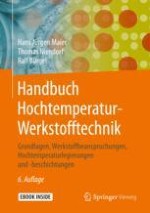2019 | OriginalPaper | Buchkapitel
3. Hochtemperaturfestigkeit und -verformung
verfasst von : Hans Jürgen Maier, Thomas Niendorf, Ralf Bürgel
Erschienen in: Handbuch Hochtemperatur-Werkstofftechnik
Verlag: Springer Fachmedien Wiesbaden
Aktivieren Sie unsere intelligente Suche, um passende Fachinhalte oder Patente zu finden.
Wählen Sie Textabschnitte aus um mit Künstlicher Intelligenz passenden Patente zu finden. powered by
Markieren Sie Textabschnitte, um KI-gestützt weitere passende Inhalte zu finden. powered by
Zusammenfassung
-
Versetzungshärtung
-
Feinkornhärtung
-
Mischkristallhärtung
-
Teilchenhärtung
